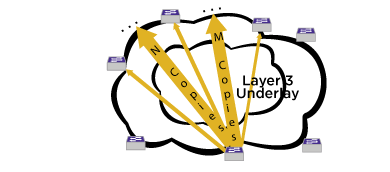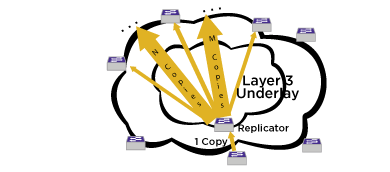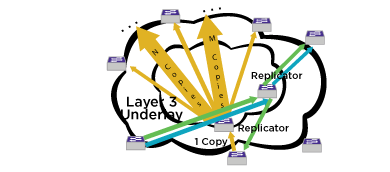Assisted Replication Overview
Assisted Replication works in conjunction with the BGP control plane and the "ipv4-vxlan" proprietary address-family. When this address-family is enabled the configured replication role and local tunnel endpoint are advertised using BGP updates, and each router selects the active replicator such that each router selects the same device. If a device is configured as a replicator, but is not selected it assumes the role of a leaf.

Note
ExtremeXOS VTEPs should not be configured as leaf.
Note
This feature should not be used with Optimized VXLAN Replication using Underlay Multicast.To get a better understanding how the assisted replication works, you must first understand what head-end replication is.
Head-End Replication
ExtremeXOS handles BUM traffic in VXLAN environments using head-end replication. Head-end replication means that each local tunnel end-point (LTEP) must replicate the frame and VXLAN encapsulate it for each remote tunnel end-point (RTEP) on the virtual network (VNI). The primary benefit of head-end replication is that it imposes no new restrictions or requirements on the underlay. All frames are unicast IP VXLAN frames, just like the normal/learned VXLAN frames. In Example Head-End Replication Topology, you can see for a given switch what the head-end replication looks for this VNI. In this case, the total copies sent by the ingress switch is N+M+3, all of which must traverse the uplinks from the ingress switch.

Assisted Replication
Assisted replication can be thought of as moving the head-end replication from every end-point to a small set of replicator nodes. The end result is the same, however, as each end-point receives a unique copy of the BC/MC frame (unique because it is unicasted directly to the end-point). Assuming the replicators are placed in the spine or core of the network, the actual number of frames traversing any single link can be greatly reduced.
In Example Assisted Replication Topology, the ingress switch needs to only send one copy of the BC/MC frame to the replicator. The replicator is then responsible for replicating the frame to all the end-nodes in the VNI. One switch can be the replicator for all VNIs in the VXLAN network, or multiple switches can be configured as the replicator for a specific set of respective VNIs.

There is no restriction on the number of replicators used in a topology. Each VNI can have its own dedicated replicator, or multiple VNI can share a replicator as shown in Assisted Replication with Multiple Replicators. This would be a network operator decision based on the amount of BC/MC traffic generated on a particular VNI. Note that both Example Assisted Replication Topology and Assisted Replication with Multiple Replicators show the path from one particular end-point to the other end-points, when in fact these paths are bi-directional and all end-points on a VNI send BC/MC to (and receive BC/MC from) the replicator. However, when the replicator role per VNI is split up, the restriction applies that a particular switch can only operate in one role: replicator or leaf.

Note
In non-EVPN environments there is no control plane learning, and there is no way for endpoints to learn the location of the user MAC addresses. In EVPN environments, which have a control plane learning model, leaf nodes learn remote addresses from the EVPN control plane, and learning is disabled on the tunnels.
Assisted Replication Roles
- Regular network virtualization edge node (RNVE)—RNVE is a regular network virtualization edge node, meaning it does not participate in the Assisted Replication, but does participate in VXLAN. This is the default role for a switch. If not defined as leaf or replicator, the switch performs normal head-end replication. RNVE nodes cannot be mixed with Assisted Replication (leaf or replicator) nodes.
- Replicator node—The replicator is the switch that performs the BC/MC replication for configured VNIs. There can be different replicators defined for any set of VNIs. The replicator is responsible for delivering BC/MC frames to all end-points (leafs) for a given VNI. There can only be one replicator configured per VNI.
- Leaf node—The leaf nodes are all other nodes participating in Assisted Replication in a VNI, excluding the replicator. Leaf nodes forward BC/MC frames to the defined replicator for the virtual network, and receive BC/MC frames from the replicator (originated from other leafs). If configured as a leaf node, the switch is configured with the IP address of the replicator for the VNI. The role of leaf is not implied on a switch. You must configure it for this role, since the default role is RNVE (meaning no Assisted Replication).
For information about configuring Assisted Replication, see Configuring Assisted Replication.

